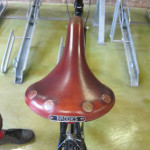Here’s Hoping that American Transportation Planners Move to the Next Level of Consciousness about Bicycling
Devotees of Stanley Kubrick know about the Monolith—that mysterious black obelisk that appears at critical points during
“2001: A Space Odyssey” to nudge humankind to a higher level of consciousness.
I have a persistent fantasy: that someday the Monolith will appear in the midst of the conference hall at a national meeting of American transportation planners—or better yet, at the annual meeting of the U.S. Conference of Mayors.
But what would happen if transportation planners and politicians touched the Monolith? What basic truth would they discover through this epiphany?
In my version of the fantasy, at least, once the cinematic music died down and the lights dimmed, they would be left with a sudden understanding that bicycling really can be an everyday means of transportation for a wide variety of the population, not just a fringe activity undertaken mostly by the young, the brave, the athletic, the (predominately) male and the environmentally inclined. And understanding that truth, they would design bicycle infrastructure accordingly.
For me, the latest reminder that we haven’t yet touched the Monolith comes in the form of the Seattle Department of Transportation’s (SDOT’s) construction plans for
Dexter Avenue.
Probably the most heavily-used bicycle-commuting corridor in the City, Dexter currently features narrow and dangerous bike lanes, sandwiched between fast-moving traffic and parked cars and often blocked by double-parked trucks. In short, it’s a dreadful excuse for a major cycling route, one that takes both dedication and a leap of faith to navigate daily.
To SDOT’s considerable credit, Dexter’s reconstruction will result in a significantly more
bike-friendly transportation environment, including wide bike lanes that will be separated from motorized traffic by a painted buffer. (In my opinion, the end result would have been better if SDOT had stuck with its original plans to build physically-separated cycle tracks, but that’s water under the bridge.)
The problem is what will happen—or rather, what won’t happen—during construction. The three-phase project, which officially began March 7, won’t be completed until the end of September. During that time, sections of roadway under construction will be two lanes during commute periods, and (at least intermittently) one lane with alternating traffic during other times. The bike lanes will be eliminated in areas under construction, and temporary cycle facilities won’t be built to replace them. In other words, cyclists will be forced to ride with heavy car traffic in the construction zone.
What’s worse, the existing pavement will be ground down, leaving a bumpy and rutted surface for cyclists to negotiate during construction. Add to this the fact that cyclists have to climb a hill going in either direction on Dexter, so the speed difference between cars and bicycles will be considerable. It all amounts to conditions that would seem to rival the infamous
Paris-Roubaix race, not exactly a magnet for your average cyclist with a healthy sense of self preservation.
So far SDOT has not suggested or signed alternative cycling routes for the Dexter corridor during construction, and in fact due to local topography and street conditions there aren’t any good ones. Instead, according to the
“Seattle Likes Bikes!” blog, City transportation officials have “stated repeatedly that cyclists will make their own route decisions based upon their individual comfort and ability.” This during the height of commuting season on what is perhaps the state’s busiest bicycle-transportation route.
Underlying SDOT’s statement is the assumption that cyclists are a bunch of hardy road warriors who can fend for themselves. The irony is that as long as SDOT and other transportation agencies continue to make this assumption, it will remain true: a perfect self-fulfilling prophesy.
On the other hand, if transportation planners want to increase cycling to a level where it actually makes a dent in our urban transportation problems, they have to stop thinking solely of the present cycling community as their “customer base” and focus more on those who don’t commute or run errands by bike, but just might be convinced to do so if the bicycle felt like a safe and convenient alternative to their car. In simple terms, take the focus off the guy on the $2,000 touring bike and place it on the mom with the kid’s seat on the back of her old cross bike. That means not only building first-class (mostly separated) bike facilities, but also making sure that cycling isn’t effectively foreclosed as an option during construction projects.
Given the present state of transportation attitudes and infrastructure in the U.S., it’s very hard to convince the average person to get on a bike. Once they do so, you don’t want to lose them. You need to do everything you can to keep them riding. That requires a consistent approach, one that makes the average person feel safe and comfortable no matter what. Good cycling conditions can’t be a sometimes thing.
The cycling nations of the Netherlands and Denmark understand this. That’s why their cycling facilities tend to be complete, convenient and connected, without gaps; and are designed not only to be safe, but also to foster a feeling of safety on the part of the average person.
 |
| Temporary bike path in Copenhagen (Copenhagenize.com) |
That’s also why those countries virtually always provide for cyclists during road construction. Temporary cycling paths are built so that travel patterns aren’t disrupted. Sometimes engineers will even close part of a highway to cars and convert it to a cycle path during a road project, or may even build a temporary freeway crossing for cyclists, as shown in the videos and links on this post by European bike blogger David Hembrow.
So congratulations to SDOT on its efforts on the Dexter Corridor, and I look forward to the final results. But in the meantime, I’ll keep searching for the Monolith.








2 Comments
Hi Ted,
Whilst I'm not familiar with the plans for Dexter Avenue I can very much relate. Being from the UK I'm pretty sure I could raise you on the close-mindedness of Transport officials.
When you're done with the Monolith, can you ship it to Britain? I'd have no quarms about covering postage and packaging.
Outstanding comment. I also find that SDOT (and WDOT) are altogether too ready to sacrifice the bike route during construction on the roadways. They attempt to accomodate cars, but the accomodation of bikes seems an afterthought at best. You are right, that is just the opposite of the mindset in Copenhagen -maybe that is partially due to the fact that Copenhagen has its own bicycle department. ing.